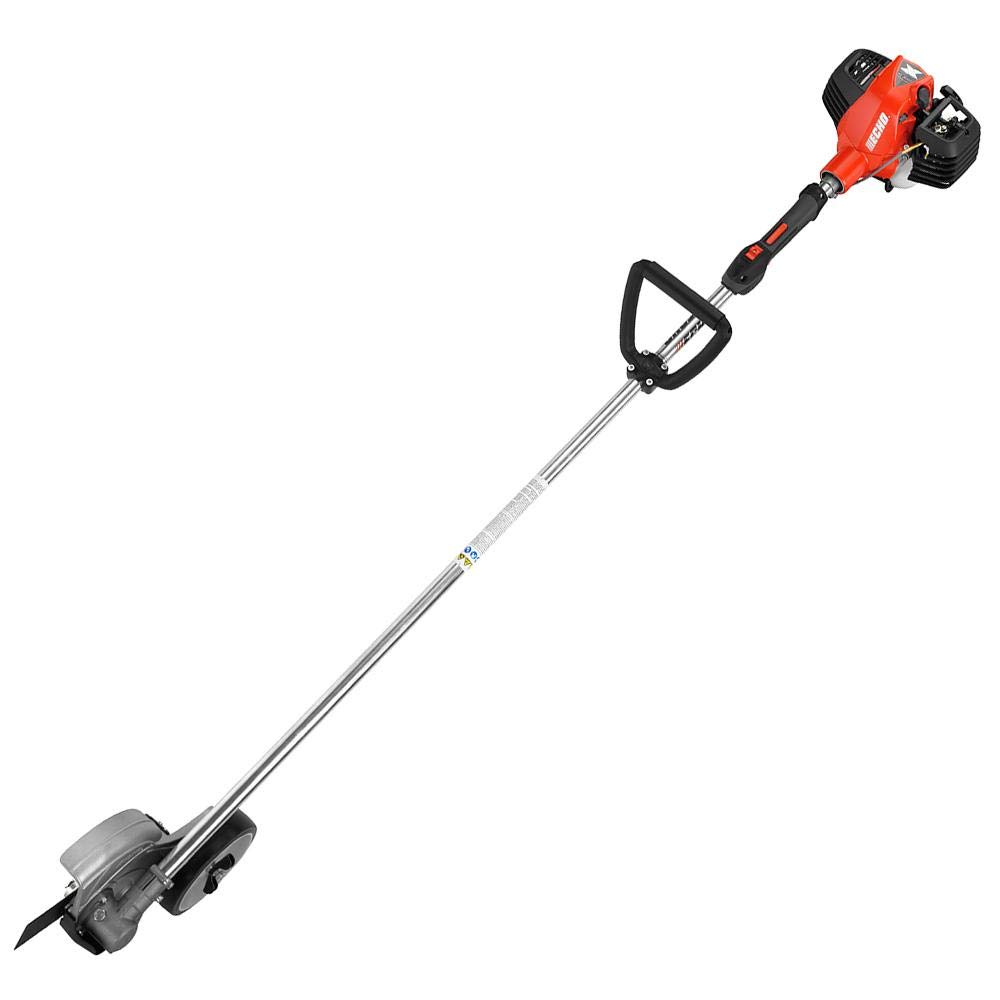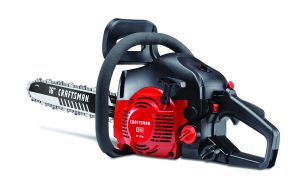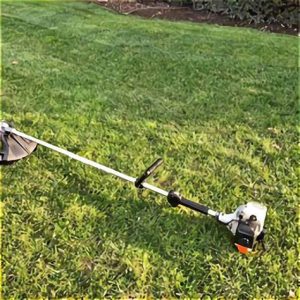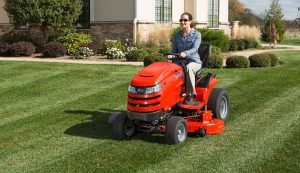ECHO Edger Common Issues (Troubleshooting Tables)
Maintaining your edger on a regular basis is crucial if you want to get the most out of it. You may prevent minor issues from becoming major catastrophes by using this method.
I’ve compiled tables with links to more detailed information to aid you in recognizing typical issues with the ECHO edger and initiating troubleshooting steps.
Always use the ECHO operator’s manual as a reference for safe practices. This includes stopping all activity and waiting for the engine to cool down. If you need to make repairs, disconnect the wire from the spark plug first.
Common Issues with ECHO Edgers:
- Edger won’t turn over
- Edger begins, then stops.
- Edger sputters and runs erratically.
- Edger only moves while wearing the choke.
- Edger runs out of power and sputters.

Table of Contents
Fixing Common ECHO Edger Issues & Fixes
ECHO Edger Starting Problem
If your edger won’t start, check for obstructions that can prevent the flow of air, fuel, and spark.
Make sure the gas-to-oil fuel ratio is 50:1 and the fuel is fresh. Due to the lack of lubrication, the engine will seize up when using plain gas.
For optimal performance, ECHO edgers need premium 2-cycle engine oil, such as Echo Power Blend or Echo Red Armor, combined with unleaded gas with an octane rating of at least 89 and no more than 10% ethanol.
More information is available at:
13 Reasons an Edger Won’t Start (How to Fix It)
| Cause | Reason for the Problem | Solution |
| Bad or stale gas | Over time, fuel loses its effectiveness and might clog up the fuel system. | Get some new gas and 2-cycle oil and refill the tank. Blend at a ratio of 50 to 1. To prevent the fuel from deteriorating and to aid in the cleaning of the fuel system, use a fuel additive such as Sea Foam. Put in quality fuel. |
| Mismatched 2-cycle oil | The engine may not get the necessary lubrication if the mixture is off. | Use a 50:1 ratio of gasoline to 2-cycle engine oil while blending. Make sure the gas you’re using has an octane value of 89 or higher and contains no more than 10% ethanol. |
| Lack of spark | It is possible to prevent the engine from starting due to a filthy or damaged spark plug, a loose spark plug wire, or an improper gap. | Put in a new spark plug, tighten the connections, and check the gap according to the manual. |
| Contaminated air filter | Blocking the air filter with dirt might be a real problem. | To clean the filter, take it apart. If the filter is damaged, you should get a new one. |
| Stuck fuel filter | A clogged gasoline filter will reduce engine performance. | Switch out the fuel filter. |
| Due to clogged gasoline lines | Old fuel’s deposits and dirt can plug the fuel lines and starve the engine of fuel. | Clear the fuel line obstruction using carburetor cleaner and compressed air. If the line is broken, replace it. |
| Vent in gasoline tank is blocked. | A blocked gasoline tank vent prevents the tank from venting. When a vacuum is created, fuel cannot escape the tank. | Unclog the fuel tank’s ventilation system. |
| Spark arrestor with a plug | When the spark arrestor becomes clogged with soot, hot air cannot escape the edger. | It’s time to clean the spark arrestor. |
| Dull carburetor | Bad fuel and ethanol deposits can cause the carburetor to get dirty and blocked, cutting off fuel supply. | Scrub the carburetor’s individual parts. If it breaks, get a new one. |
| broken primer bulb | A faulty primer bulb prevents gas from reaching the carburetor. | Change the starter light bulb. |
| Engine flooded | Too much fuel has been added to the air, making it impossible to start the engine. Too many presses on the priming bulb or pulls on the starter rope with the choke closed can cause this. | To activate, flip the switch to “run.” Choke lever must be moved to “run” position. Repeatedly pull the starter rope and press the throttle trigger to start the engine. |
| Recoil broken in starter | A non-functioning recoil is the result of a broken or otherwise damaged recoil. | See if the recoil can be restrung by checking it out. We need to replace the broken pieces. When the recoil assembly wears out, replace it.Cause of ECHO Edger Starting Problems |
ECHO Edger Starts Then Dies
A number of the same factors that prevent an ECHO edger from starting can also slow it down to the point where it eventually stops working.
Make sure you are giving the edger a proper start if it turns on but stops immediately. To start a cold engine, you must turn the choke lever to the on position.
When the engine is ready to stop running, turn the key to the off position.
| Cause | Reason for the Problem | Solution |
| Choke adjustment too tight | After the engine has warmed up, the engine will die if the choke lever is not moved to the open position. | To start a cold engine, close the choke and reduce airflow. Once the car has warmed up, you can open it. |
| Bad gas | Over time, fuel loses its effectiveness, increasing the risk of fuel system obstruction and engine damage. | Empty the gas tank and refill it with a 50:1 mixture of new gas and 2-cycle engine oil. To prevent the fuel from deteriorating and to aid in the cleaning of the fuel system, use a fuel additive such as Sea Foam. |
| Contaminated air filter | When the air filter gets clogged with dirt, it stops working. | To clean the filter, take it apart. If the filter is damaged, you should get a new one. |
| Stuck fuel filter | Inadequate fuel flow can result from a clogged fuel filter. | Switch out the fuel filter. |
| obstructed gasoline lines | The engine may not get the fuel it needs if dirt and sediment build up in the fuel lines. | To remove the obstruction from the gasoline line, you can use carb cleaning and compressed air. |
| Dull carburetor | Bad fuel and ethanol deposits can cause the carburetor to get dirty and clogged, cutting off the fuel supply. | Get the carburetor clean by washing all of its parts. If it has to be fixed, replace it. |
| Vent in gasoline tank is blocked. | A blocked gasoline tank vent prevents the tank from venting. When a vacuum is created, fuel cannot escape the tank. | Unclog the fuel tank’s ventilation system. |
| Spark arrestor with a plug | Soot can build up in the spark arrestor and prevent the exhaust of hot air. | You can use a metal brush to clean the spark arrestor screen by removing it. Repair a cracked display. |
ECHO Edger Runs Rough and Sputters
When the engine isn’t getting enough fuel, the spark plug is unclean, or hot exhaust air cannot escape, your ECHO edger will run roughly and splutter.
| Cause | Reason for the Problem | Solution |
| Wasted gasoline | Gummy deposits left behind by old fuel can block fuel flow and eventually lead to component failure. | Take out the old gas and put in a 50:1 ratio of fresh gas and 2-cycle engine oil. To prevent gas from going bad and to keep the fuel system clean, use a fuel additive such as Sea Foam Motor Treatment. |
| Unclean spark plug | A sluggish performance can be caused by an intermittent spark from a dirty spark plug. | The spark plug must be changed. |
| Stuck fuel filter | A clogged fuel filter prevents fuel from flowing effectively. | Switch out the fuel filter. |
| A gasoline line clog | When dirt or old fuel accumulates in the fuel line and causes a clog, fuel flow is reduced. | Fuel line should be cleaned or replaced. |
| Vent in gasoline tank is blocked. | If the gasoline tank can’t vent, a vacuum occurs and the fuel can’t escape. | Fix the leaking vent on the gas tank. |
| Contaminated air filter | When the air filter is clogged with dust and debris, it prevents a sufficient amount of air from passing through. | Swap out the filter. |
| Dull carburetor | Carburetor fuel passages become clogged with old gas deposits, preventing the engine from receiving enough fuel. | To clean the carburetor, take it apart. If it needs to be fixed or replaced, do so. |
| Spark arrestor with a plug | When the spark arrestor becomes clogged with soot, hot exhaust air cannot escape the edger. | The spark arrestor screen must be taken out and cleaned. |
ECHO Edger Runs With the Choke On
If your ECHO edger won’t start without the choke engaged, check for any obstructions in the fuel line or air intake. In order to properly ignite the mixture, the edger may need to use the choke.
You must also check for components that are letting in too much air. Too much inhalation necessitates the employment of the choke, which limits air intake.
More information is available at:
Why an Echo Edger Only Runs with the Choke On
| Cause | Reason for the Problem | Solution |
|---|---|---|
| Wasted gasoline | Damage to fuel systems and fuel components can be caused by varnish and deposits left behind by stale fuel. | Empty the gas tank. Add new gas and 2-cycle oil blended at a ratio of 50:1. Fuel system cleanser and fuel system stabilizer should be added. Turn the ignition on and give the gas time to circulate. |
| Damage to fuel line | The volume of air reaching the engine can be increased by sucking air into the line. | The fuel line must be changed. See whether there is any slack in the gas line. |
| Stuck fuel filter | A clogged air filter reduces ventilation. | Swap out the filter. |
| Carburetor gasket failure | Possibly too much air is getting into the carburetor because the gasket no longer seals. | Take apart the carburetor and switch out the gasket. |
| Dull carburetor | If the fuel lines become clogged, there won’t be enough gas to sustain burning. | It’s time to take the carburetor apart and give it a good scrub. If it needs to be fixed or replaced, do so. |
| Vent in gasoline tank is blocked. | If the gasoline tank’s vent is blocked, the fuel tank will develop a vacuum. As a result, fuel will be prevented from leaking from the tank. | Fix the leaking vent on the gas tank. |
ECHO Edger Loses Power and Bogs Down
If your ECHO edger seems weak or sluggish, it may be because of a clogged carburetor or other factors that limit fuel flow.
Also, make sure nothing is blocking the edger’s hot air from escaping, the engine’s air intake, or the spark plug from igniting the fuel-air mixture.
| Cause | Reason for the Problem | Solution |
|---|---|---|
| Wasted gasoline | Damage to fuel systems and fuel components can be caused by varnish and deposits left behind by stale fuel. | Empty the gas tank. Add new gas and 2-cycle oil blended at a ratio of 50:1. Fuel system cleanser and fuel system stabilizer should be added. Turn the ignition on and give the gas time to circulate. |
| Contaminated air filter | Clogged air filters prevent adequate ventilation. | Swap out the filter. |
| Unclean spark plug | The spark may be erratic if the spark plug is filthy. | Toss out and/or clean the spark plug. |
| Stuck fuel filter | Due to the blocked filter, not enough fuel can enter the engine. | Switch out the fuel filter. |
| Fuel line clog | The carburetor may not receive fuel if the fuel lines are clogged. | Either replace the fuel line or attempt to clean it. |
| Vent in gasoline tank is blocked. | If the gasoline tank’s vent is blocked, the fuel tank will develop a vacuum. As a result, fuel will be prevented from leaking from the tank. | The gas tank must be changed. |
| Spark arrestor with a plug | Soot can build up in the spark arrestor and prevent the exhaust of hot air. | You can use a wire brush to clean the spark arrestor screen by removing it. |
| Exhaust pipe clogged with carbon residue | When carbon accumulates in the exhaust pipe, it blocks the flow of hot air to the muffler. | Clear out the stack. |
| Dull carburetor | If the fuel lines become clogged, there won’t be enough gas to sustain burning. | To get rid of the varnish old fuel has left behind, you need clean the carburetor. If it needs to be fixed or replaced, do so.Cause of an ECHO Edger Loses Power & Bogs Down |
Don’t Neglect To Maintain Your ECHO Edger.
While problems with your ECHO edger are inevitable, serious ones can be kept at bay with proper maintenance.
A comprehensive maintenance service should be performed once a year on your ECHO edger.
The air filter, fuel filter, and spark plug are all replaced at each year’s service. The fuel and cooling systems, as well as the exterior, should be inspected.
Fix any dangling fasteners and replace any broken or missing pieces. In addition, you need to check the edger’s condition before starting it up to make sure it’s in working order.







